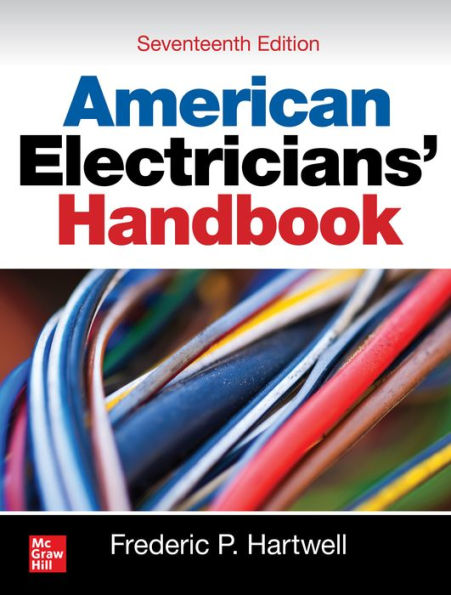Table of Contents
Preface to the Seventeenth Edition ix
Division 1 Fundamentals 1.1
Useful Tables 1.2
Conversion Factors 1.9
Graphical Electrical Symbols 1.11
Principles of Electricity and Magnetism: Units 1.21
Measuring, Testing, and Instruments 1.57
Harmonics 1.79
Division 2 Properties and Splicing of Conductors 2.1
Electrical Conducting Wires and Cables 2.1
Cable Joints and Terminal Connections 2.49
Aluminium-Building-Wire Installation Practices 2.81
Fine-Stranded Conductor Terminations 2.96
Termination and Splice Kits 2.96
Division 3 Circuits and Circuit Calculations 3.1
Types of Circuits 3.1
Electrical Systems 3.6
Circuit Calculations 3.16
NEC Ampacity Rules for Conductors 3.52
Power over Ethernet (PoE): Making Buildings Intelligent 3.66
Division 4 General Electrical Equipment and Batteries 4.1
Introduction 4.1
Switches 4.1
Installation of Switches 4.26
Protective Devices 4.28
Switchboards and Switchgear 4.61
Panelboards 4.68
General Wiring Materials and Devices 4.75
Power Capacitors 4.113
Batteries: General 4.117
Primary Batteries 4.118
Storage Batteries: General 4.121
Lead-Acid Storage Batteries 4.125
Nickel-Iron-Alkaline Batteries 4.134
Nickel-Cadmium Batteries 4.143
Lithium-Ion Batteries 4.152
Installation of Storage Batteries 4.153
General Construction Materials 4.155
Division 5 Transformers 5.1
Construction, Types, and Characteristics 5.1
Connections: Polarity 5.42
Single-Phase Connections 5.43
Two-Phase Connections 5.45
Three-Phase Connections 5.46
Special Transformer Connections 5.53
Connections for Three-Phase Transformers 5.59
Parallel Operation 5.60
Connections and Applications of Autotransformers 5.62
Installation, Care, and Operation 5.65
Provisions for Different Types of Transformers 5.70
Provisions for Transformer Vaults 5.72
The Noise Problem 5.81
Pole and Platform Mounting 5.83
Saturable-Core Reactor 5.88
Division 6 Solid-State Devices and Circuits 6.1
Fundamentals of Electronics 6.1
Discrete Solid-State Components 6.3
Integrated Circuits 6.29
Integrated-Circuit Logic Functions 6.35
Microcomputers 6.52
Electronic Memories 6.55
Product Reliability 6.64
Division 7 Generators and Motors 7.1
Principles, Characteristics, and Management of DC Generators (Dynamos) 7.1
Principles, Characteristics, and Management of AC Generators (Alternators) 7.32
Principles, Characteristics, and Management of Electric Motors 7.43
Direct-Current Motors 7.48
Alternating-Current Motors 7.56
Conversion Equipment 7.92
Troubles of AC Motors and Generators: Their Localization and Correction 7.94
Care of Motors 7.100
Control Equipment for Motors 7.107
Motor Drives and Application 7.159
Motor Circuits 7.176
Control Circuits 7.192
Industrial Control Panels 7.194
Air-Conditioning and Refrigerating Equipment 7.198
Engine-Driven and Gas-Turbine Generators 7.203
Division 8 Outside Distribution 8.1
Pole Lines: General, Construction, and Equipment 8.1
Pole-Line Construction 8.29
Pole-Line Guying 8.49
Underground Wiring 8.58
Grounding of Systems 8.71
Division 9 Interior Wiring 9.1
General 9.2
Open Wiring on Insulators 9.11
Concealed Knob-and-Tube Wiring 9.21
Rigid-Metal-Conduit and Intermediate-Metal-Conduit Wiring 9.21
Cable Pulling Calculations for Raceways 9.50
Interior or Aboveground Wiring with Rigid Nonmetallic Conduit 9.57
Flexible-Metal-Conduit Wiring 9.62
Liquidtight Flexible-Metal-Conduit Wiring 9.65
Metal-Clad-Cable Wiring: Types AC and MC 9.66
Surface-Raceway Wiring 9.70
Electrical-Metallic-Tubing Wiring 9.76
Nonmetallic-Sheathed-Cable Wiring 9.79
Mineral-Insulated Metal-Sheathed-Cable Wiring 9.84
Underground-Feeder and Branch-Circuit-Cable Wiring 9.91
Interior Wiring with Service-Entrance Cable 9.91
Underfloor-Raceway Wiring 9.93
Wireway Wiring 9.109
Busway Wiring (NEMA) 9.110
Cellular-Metal-Floor-Raceway Wiring 9.136
Cellular-Concrete-Floor-Raceway Wiring 9.146
Wiring with Multioutlet Assemblies 9.154
Cablebus Wiring 9.160
Cable Trays 9.163
General Requirements for Wiring Installations 9.168
Crane Wiring 9.207
Wiring for Circuits of Over 600 V (Medium Voltage) 9.214
Wiring for Circuits of Less than 50 V 9.217
Wiring for Hazardous (Classified) Locations 9.217
Installation of Appliances 9.225
Electric Comfort Conditioning 9.226
Wiring for Electric Signs and Outline Lighting 9.246
Remote-Control, Signaling, and Power-Limited Circuits 9.251
Wiring for Special Occupancies 9.255
Design of Interior-Wiring Installations 9.256
Wiring for Residential Outdoor Lighting 9.261
Wiring for Commercial and Industrial Occupancies 9.265
Working with Dissimilar Metals 9.294
Farm Wiring 9.296
Solar Photovoltaic Systems 9.304
Division 10 Electric Lighting 10.1
Principles and Units 10.1
Electric-Light Sources 10.19
Incandescent (Filament) Lamps 10.19
Fluorescent Lamps 10.32
High-Intensity-Discharge Lamps 10.48
Light-Emitting Diodes (LEDs) 10.61
Neon Lamps 10.62
Ultraviolet-Light Sources 10.67
Infrared Heating Lamps 10.70
Luminaires 10.71
Principles of Lighting-Installation Design 10.88
Tables for Interior Illumination Design 10.103
Interior-Lighting Suggestions 10.123
Heat with Light for Building Spaces 10.126
Street Lighting 10.128
Floodlighting 10.132
Division 11 Optical Fiber 11.1
The Advantages of Fiber Optics 11.1
Applications 11.2
The Nature of Light 11.2
Invisible Light 11.3
Transmitting Light Through Fibers 11.3
Division 12 Wiring and Design Tables 12.1
Standard Sizes of Lamps for General Illumination, in Watts 12.3
Demand Factors and Data for Determining Minimum Loads 12.4
Full-Load Currents of Motors 12.10
Capacitor Ratings for Use with Three-Phase 60-Hz Motors 12.13
Ampacities of Conductors 12.14
Ampacity of Flexible Cords and Cables 12.28
Ampacity of Fixture Wires 12.31
Ampacity of Aluminum Cable, Steel-Reinforced 12.31
Ampacity of Parkway Cables Buried Directly in Ground 12.32
Notes to NEC Tubular Raceway and Wire Dimension Tables 12.32
Wire-Bending Space, Entries Adjacent to Terminals 12.33
Wire-Bending Space, Entries Opposite Terminals 12.34
Enclosed Switch Wiring Space 12.35
Elevation of Unguarded Parts above Working Space 12.36
Ordinary Ratings of Overload Protective Devices, in Amperes 12.37
Nonrenewable Cartridge Fuses 12.39
Ratings and Number of Overload Protective Devices 12.44
Motor Code Letters and Locked-Rotor Kilovolt-Amperes 12.46
Maximum Ratings for Motor Branch-Circuit Protection 12.47
Conversion Table of Single-Phase Locked-Rotor Currenis 12.47
Conversion Table of Polyphase Design B, C, D, and E Maximum Locked-Rotor Currents 12.48
Horsepower Ratings of Fused Switches 12.49
Minimum Branch-Circuit Sizes for Motors 12.50
Maximum Allowable Voltage Drop 12.51
Graph for Computing Copper-Conductor Sizes According to Voltage Drop 12.53
Data for Computing Voltage Drop 12.54
Metric Practice 12.62
Division 13 Electrical Safety 13.1
Historical Overview of Energized Work 13.1
General Requirements for Electrical Safety-Related Work Practices 13.3
Electrically Safe Working Conditions Must Be Established and Controlled 13.17
Work Involving Electrical Hazards 13.30
Index follows Division 13






